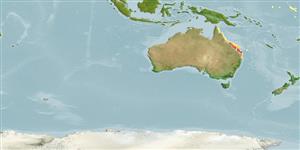التصنيف / Names
الأسماء الشائعة | مرادفات | Catalog of Fishes(جنس, الانواع) | ITIS | CoL | WoRMS | Cloffa
>
Ophidiiformes (Cusk eels) >
Dinematichthyidae (Viviparous brotula)
Etymology: Didymothallus: Name from Greek 'didymos' for double or twofold and 'thallus' for branch in plants, referring to the two supporters of nearly equal length in the single pair of pseudoclaspers; criniceps: Name from Latin 'crinis' for hair and Greek 'cephalos' for head, refers to the many hair-like cirri on the occiput.
More on authors: Schwarzhans & Møller.
Environment: milieu / climate zone / depth range / distribution range
البيئة
بحري مرتبطة بالشعاب; نطاق العمق 0 - 5 m (Ref. 76869). Tropical
Western Pacific: Australia.
الحجم / وزن / العمر
Maturity: Lm ? range ? - ? cm
Max length : 5.4 cm SL ذكر/ مختلط الجنس; (Ref. 76869); 6.0 cm SL (female)
وصف مختصر
مفاتيح التعريف | الوصف الخارجي | قياسات المظهر الخارجي
الأشعة الظهرية الناعمة (المجموع) : 69 - 77; أشعه شرجية لينه: 52 - 61; فقرات: 42 - 45. This species is diagnosed by the following characters: D 69-77; A 52-61; D/A 23-26, V in D 1.9-2.1; vertebrae 12+30-33=42-45; multiple small cirri on occiput; a single (outer) pseudoclasper wing-shaped with 2 slender supporters, slightly bent, particularly the posterior one and are exactly of same length; 3-5 rows of scales on upper part of cheek, 2 rows on its lower part; otolith has a moderately pointed anterior tip and pronounced postdorsal angle, with undivided short sulcus, its centre anterior to centre of otolith, inclined with 5 to 10°, the otolith length to otolith height is 2.2, otolith length to sulcus length is 2.2-2.4 (Ref. 76869).
Some of the female specimens were observed to have 9-18 eggs in the body cavity, 2 females (of 44 mm SL) were opened and found to contain orange-coloured eggs, 1.4-1.7
mm in diameter; no reported specimens have embryos inside. This observation apparently indicate that this species is oviparous rather than viviparous, which is an assumed diagnostic character for all Bythitoidei. However, this first indication will need to be confirmed by in-life observation (Ref. 76869).
Life cycle and mating behavior
النضج | التكاثر | وضع البيض | بيض | الخصوبة | Larvae
Schwarzhans, W. and P.R. Møller, 2007. Review of the Dinematichthyini (Teleostei: Bythitidae) of the Indo-west Pacific. Part III. Beaglichthys, Brosmolus, Monothrix and eight new genera with description of 20 new species. The Beagle, Records of the Museums and Art Galleries of the Northern Territory 23:29-110. (Ref. 76869)
IUCN Red List Status (Ref. 130435: Version 2024-2)
استخدامات بشرية
أدوات
تقارير خاصة
Download XML
مصادر علي الأنترنت
Estimates based on models
Preferred temperature (Ref.
123201): 24.7 - 27.2, mean 26.1 °C (based on 251 cells).
Phylogenetic diversity index (Ref.
82804): PD
50 = 0.5625 [Uniqueness, from 0.5 = low to 2.0 = high].
Bayesian length-weight: a=0.00389 (0.00180 - 0.00842), b=3.12 (2.94 - 3.30), in cm total length, based on all LWR estimates for this body shape (Ref.
93245).
مستوى غذائي (Ref.
69278): 3.3 ±0.5 se; based on size and trophs of closest relatives
Fishing Vulnerability (Ref.
59153): Low vulnerability (10 of 100).
